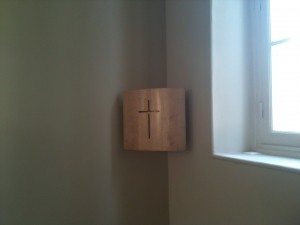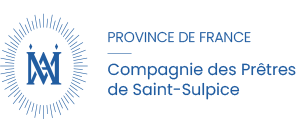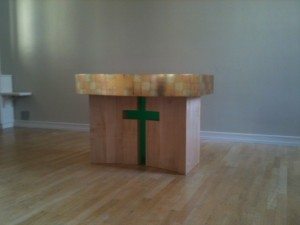Un mobilier liturgique, signe de l’accueil, de la rencontre et de la prière
Michel Caussin, l’artiste qui a conçu le mobilier sacré, était intéressé de répondre à la demande qui lui était faite. « En union de vue avec le p. Magne, j’ai essayé de remettre du sens dans les objets du culte afin que les personnes qui entrent dans cette chapelle y soient sensibles », précise-t-il.
Par exemple, l’autel est conçu avec certains symboles. Ils n’apparaissent pas d’emblée. La surface concave symbolise l’accueil : quand on accueille, on ouvre les bras, on fait un creux. Le creux mène à la croix.
Le plateau est dans une forme inversée, la courbe vient vers l’assemblée pour symboliser le don du Christ qui se donne à celui qui s’avance vers Lui. Ainsi, la structure même de l’autel reprend ce que nous avons à dire du Christ.
Le tabernacle est placé dans l’angle du mur, directement en diagonale de la porte d’entrée de la chapelle. A nouveau, la porte du tabernacle est en creux, avec une croix lumineuse. La lumière qui éclaire est une lumière intérieure au tabernacle !

Les temps liturgiques seront aisément marqués par la couleur qui peut être changée. La croix de l’autel pourra ainsi s’animer de blanc, de vert, de rouge, de violet tout au long de l’année liturgique, ressortant d’autant mieux que le mobilier est d’une couleur très claire.
New chapel furniture enhancing meeting and prayer
Michel Caussin, the artist who created the sacred furniture, was interested in meeting the requirement which had been made to him. « Thinking alike with Fr. Magne, I tried to put meaning in the cult objects so that those who enter the chapel are sensitive to them », he said.
For example, the altar has been developed including symbols. They don’t always appear straight away. The concave surface symbolises welcome: when you welcome someone, you open your arms, you form a shape like a trough. This leads you to the cross.
The top has a mirror shape with a curve that goes towards the assembly in order to symbolise the gift of Christ who gives Himself to he who comes to Him. Thus, the structure itself of the altar relies on what we have to say of Christ.
The tabernacle is placed in the corner of the chapel, directly in a diagonal with the opening door of the chapel. Here again, the tabernacle door is concave, with a luminous cross, and the cross is lit up by the light which is inside the tabernacle!
The liturgical times are easily marked by the colour which can change. The altar cross can change from white to green, from red to purple throughout the liturgical year, and shows up all the more that the furniture is of a very light colour.


